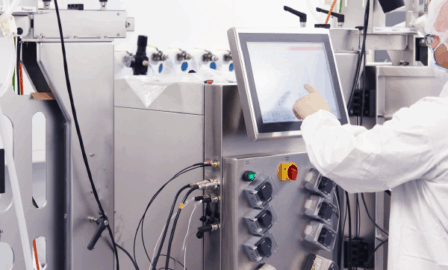Part 1: A Supply Chain Predictive Analytics Conversation
I had a recent opportunity to get Patrik Latin's perspective, as a senior pharmaceutical executive, on what predictive analytics means for the future of supply chain. I am so pleased to share his vision for with you through this blog series.
In this post (Part 1) we’ll set the stage for predictive analytics – what is it and where did these analytics evolve from? In the upcoming posts, we’ll discuss why supply chain predictive analytics are important for supply chain executives to incorporate into their modeling practices (Part 2) and how to get started incorporating these data elements into your process (Part 3).
Sebastian: What is behind the “buzz” of predictive analytics? Is there real value there for supply chain executives at pharmaceutical companies? And, with so many buzz words out there, how do you define and differentiate across descriptive, predictive, and prescriptive analytics?
Patrik: Beyond the buzz word, there is no doubt there is real value from predictive analytics and not only throughout the supply chain but it also has the potential to increase total value for the top and bottom line for the company. Predictive models will allow us to improve our decision-making throughout the supply chain but the results will be seen in growth and cost-reductions. In terms of the different types of analytics, consider these definitions:
- Descriptive analytics is reporting or analyzing what happened in the past
- Predictive analytics is alerting or analyzing what could happen
- Prescriptive analytics gives you the best option given a current situation
Each of these types of analytics still have a role in pharmaceutical companies. But, predictive analytics will force us to consider the future, making assumptions, and take the best decision based on the outcome of these analytics. Thanks to the massive increase in valuable data access and computing power we are now able to put much more power into the analysis and make better decisions.
Sebastian: Thanks for providing your perspective on the different type of analytics. Let’s talk more about your comment on how it can impact the top and bottom line. How does using predictive analytics differentiate your company from the competition and help increase shareholder value?
Patrik: Well, overall this is improving the decision-making process in the various disciplines, resulting in faster acting to changes, higher efficiencies and productivity, to even postponing capital expenditures, so the value increase is clear to me. In one example, at one of our plants, in one of our lines, we applied predictive analytics as a pilot case, and increased capacities, which significantly reduced our cost per dose; we achieved 17% cost per unit reduction on that first line; and for other lines thereafter, we were at about $50M in cost savings in only year 1. We not only gained productivity, throughput, and reduced cost per unit, but it prevented us from buying additional capacity which we were about to do. So, if you consider the financial component, we postponed cost of capital (using 8% internal rate of return or hurdle rate of 12%) on money we freed up by not installing unnecessary capacity.
Sebastian: That’s a great example of how predictive analytics is impacting companies in a real way! We also see at our clients that there’s a link between predictive analytics and serialization work. What’s the intersection between the two? With the abundance of many more data points, how can serialization help predictive analytics initiatives?
Patrik: With serialization, we can identify where all our products are at all times, leading to a new level of inventory accuracy, even across legal entities and in some cases with customers and vendors. This real transparency of our products will be very revealing and this data can be used to alert to potential inventory scenarios. Most pharmaceutical companies have invested a lot of capital in complying with serialization globally; when that data is leveraged with predictive analytics, there is a different use case and value justification outside of regulatory compliance.
Download our predictive analytics e-book
Sebastian: Are there any current companies using predictive analytics to great success? Are there other industries that are using it well that could be sources of lessons learned? What’s the tangible value?
Patrik: I feel that we have great signs of progress and advancement in this field in the pharmaceutical companies where I have worked. This isn’t an easy journey, but it is a very rewarding one. But, there is a lot still to be done. Pharmaceutical companies should be incorporating advanced predictive models into critical functions the way financial organizations do to prevent fraud and theft. Retail companies have invested heavily and connected different sets of data, structured and unstructured, to predict purchasing behavior, and increase share of wallet of the consumers. The life sciences industry is lagging behind other industries but this presents an opportunity for a first mover advantage to the right company.
Thank you again, Patrik, for providing your insights on supply chain predictive analytics. It seems fitting that we should end Part 1 with a call to action for pharmaceutical companies to invest in a first mover advantage. In our upcoming posts (Part 2) hear more examples of the benefits of predictive analytics and how to get started at your company (Part 3).
Interested in learning more? Download Clarkston’s latest e-book, A Supply Chain Predictive Analytics Conversation
About the Authors
Patrik Latin is an enthusiastic business executive with over 25 years of international leading experience in multi-national healthcare companies. Patrik is a proven leader with a specialization in the areas of management, supply chain, operations and strategic procurement. Patrik is passionate about innovation and transformation of an organization during this new digital era with IoT, big data, blockchain technology, predictive analytics to bring them to a new maturity level of excellence.
is an enthusiastic business executive with over 25 years of international leading experience in multi-national healthcare companies. Patrik is a proven leader with a specialization in the areas of management, supply chain, operations and strategic procurement. Patrik is passionate about innovation and transformation of an organization during this new digital era with IoT, big data, blockchain technology, predictive analytics to bring them to a new maturity level of excellence.
Sebastian Valencia , partner with Clarkston Consulting, is responsible for advising senior executives from international organizations. He has extensive experience in supply chain strategy and distribution redesign, outsourcing through third party logistic providers, mergers and acquisitions, vendor selection, pricing and negotiation of supply chain contracts, and distribution network optimization.
, partner with Clarkston Consulting, is responsible for advising senior executives from international organizations. He has extensive experience in supply chain strategy and distribution redesign, outsourcing through third party logistic providers, mergers and acquisitions, vendor selection, pricing and negotiation of supply chain contracts, and distribution network optimization.



